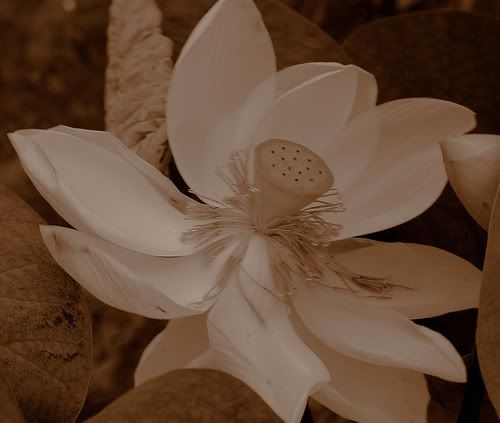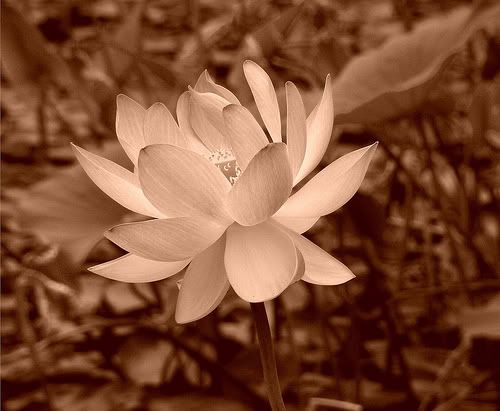Grown In Darkness To Emerge To The Sun ~ The Lotus

'In the beginning were the waters. Matter readied itself. The sun glowed. And, a lotus slowly opened, holding the universe on its golden pericarp.' This is precisely the Indian myth of creation as also of the birth of her most majestic flower abounding in supreme beauty, sublime grace and the aura of transcendence. Waters rise but the lotus rises above them. The sun burns and freezing winters mount but the lotus neither sweats nor shivers. And, cyclones move the earth but the rising dust, enshrouding everything from the earth to the sky, does not reach it. Nothing pollutes its purity, nor affects anything its celestial quiescence. Neither the winds shake it nor does frost freeze. Depths below and heights above do not frighten it. Detached it couches over its resplendent bed stretching far and wide cradling on its bosom the forms from the world around and the formlessness from above. When a Buddha's devotee chants: 'Aum mani padme hum', he knows that 'padma' - lotus, is the 'mani' - gem, as having material status the lotus belongs to form, but in it is revealed more characteristically the formless spiritual element, the supreme jewel - the 'mani', that unfolds within, as do lotus petals.
This lotus, in which gods discovered their grace and majesty, poets, painters and sculptors, the subtlest expression of beauty, and mystics, dimensions of mysticism and intricate cosmic existence, is primarily the flower of India.
Myths of Its Origins
Though just a flower, lotus has many legends in regard to its mythical origin, which its great spiritual significance and the status with which a flower is not usually endowed, has inspired. More prominent is the legend of 'Samudra-manthana' - ocean churning.
It is said that once gods and demons reached an agreement that they would jointly churn the ocean to obtain from it nectar that it hid in its bottom. When the churning was in process, ocean revealed fourteen precious jewels and lotus with Lakshmi mounting it was one of them.
Thus, lotus was born from the womb of the ocean. The Bhagavata, Matsya and several other Puranas have a different version of the origin of lotus. After the Great Deluge, Vishnu appeared on the surface of the milk-white waters of the Kshirasagara - ocean of milk. He wished the Creation were rendered. Instantly, from his naval rose a lotus carried upon a mighty stem with Brahma, the Creator, mounting it. The first lotus thus grew from the body of Lord Vishnu.
A Shiva-related legend claims its origin from Shiva's seed. Once Shiva was engaged in love with Parvati for many thousand years and did not come out of his chamber. In his absence, demons grew stronger and defeated and humiliated gods on every occasion. Finally, gods went to Shiva and prayed him to stop his love-game and to come to their rescue. Shiva agreed but the problem was where the semen was shed. Agni - fire proposed to bear it but before long it became unbearable and hence Agni let it fall on the earth. Instantly, the spot where it fell turned into a huge lake with abundant lotuses, and thus was born the divine flower. Lotus is also related to Kuber, the lord of riches. As the tradition has it, 'Padam' - lotus, was one of Kuber's 'Nidhis' - treasures. To assist Vishnu, the sustainer of the world, Kuber sent 'Padam' to the earth where it emerged as lotus flower. This symbolism closely corresponds to the emergence of Lakshmi, the Lotus goddess, Vishnu's female aspect and primary instrument of sustaining universe.

Lotus: A Continuous Presence Over 5000 Years
Whatever myths of its origin, lotus as a flower had an early presence, at least during the Indus days if not before. Scholars have discovered in the rock-shelter drawings a few motifs, which they feel were representations of lotus. The often illustrated is the drawing looking like a trident from Abchand, Sagar, in Madhya Pradesh. More convincing than the drawing is their argument. They contend that caves' dwellers could not have been unacquainted with lotus, when they had seen and were attracted to a fish and crocodile - the other inhabitants of water, and drew them on their walls.
By Indus days, however, lotus, both as a decorative motif and as symbol, seems to have become quite popular. The pottery excavated from Mohanjo daro in Indus Valley is found painted with designs composed of lotus-petal-type leaf-patterns. The characteristic Indus terracotta seals bear motifs, which correspond to lotus. A late mother-goddess figurine from Mathura, an obvious continuity of the Indus cult and model, has well-defined lotus motifs in its coiffeur.
Lotus in Early Texts
Allusions to lotus in texts of subsequent days are abundant.
Lotus significantly figures in the entire body of Sanskrit literature - poetry and drama, though primarily for its aesthetic beauty in which poets found an apt parallel to the beauty of the woman and sometimes of the divine or celestial beings.
Lotus in Buddhist Art
Lotus, however, emerges as a mighty factor influencing various arts from third century B. C. after the Mauryan emperor Ashoka had the capitals of his pillars designed with the motif of lotus to serve as the base for the animal figures surmounting pillar's apex.
Before Buddha was conceived, Maya, his mother, dreamt that a white young elephant, with a lotus in its trunk, entered her womb. And, after his birth, Buddha is said to have got up and walked seven steps, and wherever the foot was laid, a lotus rose.
Thus, lotus attained great significance in Buddhism even before Buddha was born, and emperor Ashoka must have been acquainted with it when he chose a lotus motif for his pillars. The influence was immense. In the entire Sunga art, after Ashoka, across third to first century B. C., at Bharhut, Sanchi, Amaravati and other Buddhist centers, lotus surpassed almost all other art motifs. The variedly conceived and carved lotus motifs served sometimes as components to a theme and at other times as an independent art-subject. Medallions, squares and other geometric patterns, designed with lotuses or lotus creepers, entwining in them figures of 'yakshas', elephants, goddesses and various celestial beings, carved on railings, gateways, pillars, pilasters etc. were the common features of the art of this period. Lotus buds and flowers, along with leaves, featured as decorative elements also in sculptures portraying different 'jatakas' and other themes - a hermitage, for example.
Lama Anagarika Govinda of the Foundation of Tibetan Mysticism perceived in lotus the living synthesis of the deepest and the highest, darkness and light, material and immaterial, limitation of the individuality and boundlessness of universality, the forms and the formless, and samsara and nirvana. Such mystic character of lotus inspired the Buddhist mind - of the devotee and the artist, to bow to it in reverence.
Have questions?
Need help? Visit our Support Group for help from our friendly Admins and members!
Have you?
Donations & Sponsorship
Connect
Visit The Temple
on Facebook:
Blog Posts
Channeled Angelic Wisdom of the Jewels of Truth Series on Beneficence and Heaven on Earth
Posted by Atrayo on April 17, 2024 at 10:26am 0 Comments 1 Like
Channeled Angelic Wisdom of the Jewels of Truth Series on Unconditional Truth and Free Will
Posted by Atrayo on April 14, 2024 at 7:54am 0 Comments 1 Like
Channeled Angelic Wisdom of the Jewels of Truth Series on The Afterlife, God, & World Peace
Posted by Atrayo on April 6, 2024 at 1:51pm 0 Comments 1 Like
coat of arms of McIntyre clan.
Posted by Ghillie Dhu on March 2, 2024 at 5:06am 4 Comments 0 Likes
Channeled Angelic Wisdom of the Jewels of Truth Series on Destiny, Future Past, and Meta-Genesis
Posted by Atrayo on February 22, 2024 at 12:54am 0 Comments 1 Like
Channeled Angelic Wisdom of the Jewels of Truth Series on Sex Addicts and Jealousy
Posted by Atrayo on February 14, 2024 at 6:57pm 0 Comments 1 Like
Are Ouija Boards Evil?
Posted by Bill Walker on February 1, 2024 at 8:15pm 1 Comment 1 Like
PAGAN GLBTQ Pansexual/Hetero ADULT QUANTUM ECLECTIC BOOK LIST - PARTS 1 & 2 - 2024
Posted by Sky a.k.a. JD Aeon on January 7, 2024 at 4:43am 1 Comment 5 Likes
Channeled Angelic Wisdom of the Jewels of Truth Series on The True Sons and Daughters of God, Decision Making, God, and Majesty of Being
Posted by Atrayo on December 29, 2023 at 1:04pm 0 Comments 1 Like
TO RISE AND FIGHT AGAIN
Posted by Kitt on December 14, 2023 at 8:55pm 2 Comments 4 Likes
Channeled Angelic Wisdom of the Jewels of Truth Series on Spiritual Modesty, Exalted, Glories of God, & Grace
Posted by Atrayo on November 29, 2023 at 11:21pm 0 Comments 2 Likes
Osiris the Warlock: The Cursed
Posted by 06iiris on October 13, 2023 at 8:30am 0 Comments 1 Like
Osiris the Warlock: Horus Lives!
Posted by 06iiris on October 13, 2023 at 7:00am 0 Comments 0 Likes
Osiris the Warlock: Nanna-Sin
Posted by 06iiris on October 12, 2023 at 3:30pm 0 Comments 0 Likes
Osiris the Warlock: Daemon
Posted by 06iiris on October 12, 2023 at 6:00am 0 Comments 0 Likes
Osiris the Warlock
Posted by 06iiris on October 12, 2023 at 5:30am 0 Comments 0 Likes
The (3l)ack & Red Dragon
Posted by 06iiris on October 11, 2023 at 1:00pm 0 Comments 0 Likes
The Sin (3l)ood Omen (II)
Posted by 06iiris on October 11, 2023 at 8:30am 0 Comments 0 Likes
The Sin (3l)ood Omen
Posted by 06iiris on October 9, 2023 at 7:30am 0 Comments 0 Likes
The 3nki (Doc)trine: Ptah-Øsiris
Posted by 06iiris on October 5, 2023 at 1:00pm 0 Comments 0 Likes
NOVEMBER AWARENESS
Videos
-
Two Become One
Added by Imelda James 0 Comments 0 Likes
-
You and I Love
Added by Imelda James 0 Comments 0 Likes
-
Deuce - America
Added by Bryan_Thoth 0 Comments 0 Likes
© 2024 Created by Bryan
Powered by
![]()

You need to be an initiate of Temple Illuminatus to add comments!
Join Temple Illuminatus